- Bitcoin mining difficulty reaches a record high of 52.35 trillion, reflecting intense competition among miners.
- The average hashrate of the Bitcoin network is nearing an all-time high.
- Rising Bitcoin mining difficulty highlights a healthy and active network, but also raises complexity and resource demands.
Bitcoin mining difficulty has reached a new record high, as indicated by data from BTC.com. At block height 794,304, the mining difficulty increased by 2.18% to reach a peak of 52.35 trillion.
The average hashrate of the entire network, another important metric, is currently at 383.87 exahashes per second, which is close to its all-time high. Mining difficulty is a relative measure of the resources needed to mine new Bitcoin, and it adjusts to maintain an average block creation time of around 10 minutes as more miners join the network.

Data shows upward Bitcoin mining difficulty
This adjustment occurs approximately every two weeks or every 2016 block. A higher difficulty level indicates heightened competition among miners in solving the mathematical problem essential for blockchain block additions. The data shows a general upward trend in Bitcoin mining difficulty throughout the year, with occasional fluctuations.
Despite some minor drops in early February and May, the difficulty level has continued to rise, culminating in the recent record high. This increase indicates a robust and active Bitcoin network with growing participation from miners. However, it also implies a more complex mining process, requiring additional resources and computational power.








